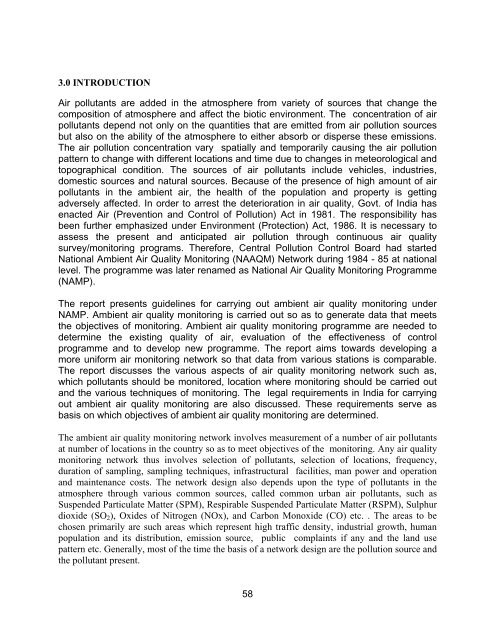Ambient Air quality Monitoring Guidlines. - Maharashtra Pollution ...
Ambient Air quality Monitoring Guidlines. - Maharashtra Pollution ...
Ambient Air quality Monitoring Guidlines. - Maharashtra Pollution ...
You also want an ePaper? Increase the reach of your titles
YUMPU automatically turns print PDFs into web optimized ePapers that Google loves.
3.0 INTRODUCTION<br />
<strong>Air</strong> pollutants are added in the atmosphere from variety of sources that change the<br />
composition of atmosphere and affect the biotic environment. The concentration of air<br />
pollutants depend not only on the quantities that are emitted from air pollution sources<br />
but also on the ability of the atmosphere to either absorb or disperse these emissions.<br />
The air pollution concentration vary spatially and temporarily causing the air pollution<br />
pattern to change with different locations and time due to changes in meteorological and<br />
topographical condition. The sources of air pollutants include vehicles, industries,<br />
domestic sources and natural sources. Because of the presence of high amount of air<br />
pollutants in the ambient air, the health of the population and property is getting<br />
adversely affected. In order to arrest the deterioration in air <strong>quality</strong>, Govt. of India has<br />
enacted <strong>Air</strong> (Prevention and Control of <strong>Pollution</strong>) Act in 1981. The responsibility has<br />
been further emphasized under Environment (Protection) Act, 1986. It is necessary to<br />
assess the present and anticipated air pollution through continuous air <strong>quality</strong><br />
survey/monitoring programs. Therefore, Central <strong>Pollution</strong> Control Board had started<br />
National <strong>Ambient</strong> <strong>Air</strong> Quality <strong>Monitoring</strong> (NAAQM) Network during 1984 - 85 at national<br />
level. The programme was later renamed as National <strong>Air</strong> Quality <strong>Monitoring</strong> Programme<br />
(NAMP).<br />
The report presents guidelines for carrying out ambient air <strong>quality</strong> monitoring under<br />
NAMP. <strong>Ambient</strong> air <strong>quality</strong> monitoring is carried out so as to generate data that meets<br />
the objectives of monitoring. <strong>Ambient</strong> air <strong>quality</strong> monitoring programme are needed to<br />
determine the existing <strong>quality</strong> of air, evaluation of the effectiveness of control<br />
programme and to develop new programme. The report aims towards developing a<br />
more uniform air monitoring network so that data from various stations is comparable.<br />
The report discusses the various aspects of air <strong>quality</strong> monitoring network such as,<br />
which pollutants should be monitored, location where monitoring should be carried out<br />
and the various techniques of monitoring. The legal requirements in India for carrying<br />
out ambient air <strong>quality</strong> monitoring are also discussed. These requirements serve as<br />
basis on which objectives of ambient air <strong>quality</strong> monitoring are determined.<br />
The ambient air <strong>quality</strong> monitoring network involves measurement of a number of air pollutants<br />
at number of locations in the country so as to meet objectives of the monitoring. Any air <strong>quality</strong><br />
monitoring network thus involves selection of pollutants, selection of locations, frequency,<br />
duration of sampling, sampling techniques, infrastructural facilities, man power and operation<br />
and maintenance costs. The network design also depends upon the type of pollutants in the<br />
atmosphere through various common sources, called common urban air pollutants, such as<br />
Suspended Particulate Matter (SPM), Respirable Suspended Particulate Matter (RSPM), Sulphur<br />
dioxide (SO2), Oxides of Nitrogen (NOx), and Carbon Monoxide (CO) etc. . The areas to be<br />
chosen primarily are such areas which represent high traffic density, industrial growth, human<br />
population and its distribution, emission source, public complaints if any and the land use<br />
pattern etc. Generally, most of the time the basis of a network design are the pollution source and<br />
the pollutant present.<br />
58
















